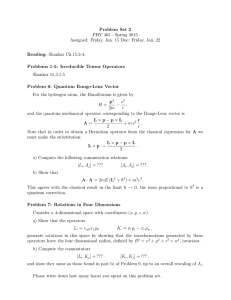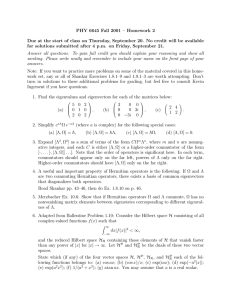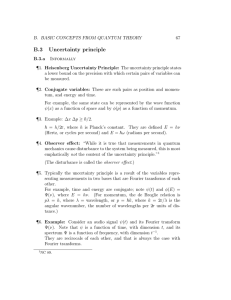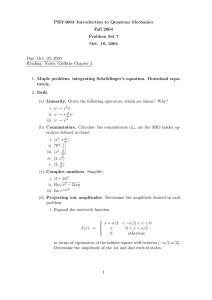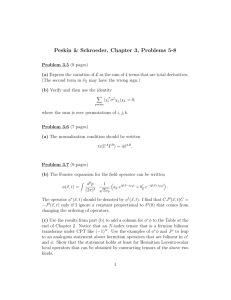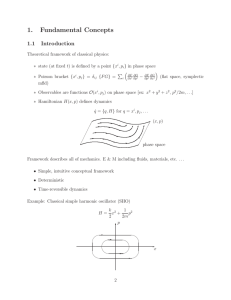Homework Assignment 03: Function of Operators; Quantum Measurements ( ) Due: 02/11/2016
advertisement
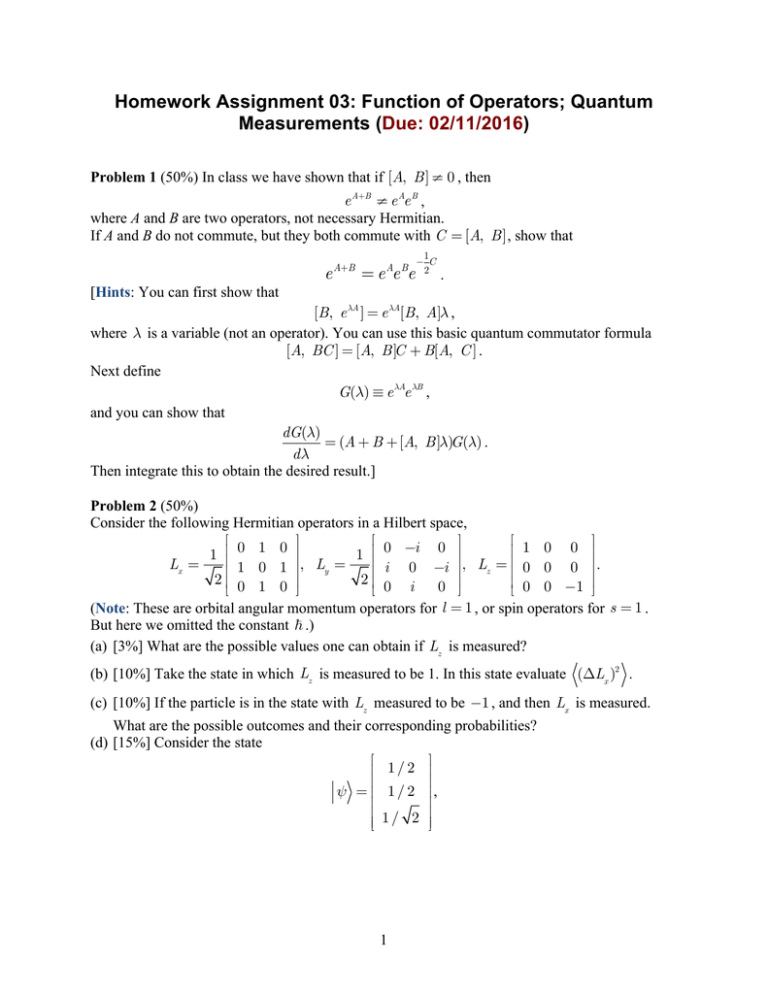
Homework Assignment 03: Function of Operators; Quantum Measurements (Due: 02/11/2016) Problem 1 (50%) In class we have shown that if [A, B] ≠ 0 , then e A+B ≠ e Ae B , where A and B are two operators, not necessary Hermitian. If A and B do not commute, but they both commute with C = [A, B] , show that e A+B A B =e e e 1 − C 2 . [Hints: You can first show that [B, e λA ] = e λA[B, A]λ , where λ is a variable (not an operator). You can use this basic quantum commutator formula [A, BC ] = [A, B]C + B[A, C ] . Next define G(λ) ≡ e λAe λB , and you can show that dG(λ) = (A + B +[A, B]λ)G(λ) . dλ Then integrate this to obtain the desired result.] Problem 2 (50%) Consider the following Hermitian operators in a Hilbert space, ⎡ ⎤ ⎡ ⎤ ⎡ 1 0 0 ⎤ ⎢ ⎥ 1 ⎢⎢ 0 1 0 ⎥⎥ 1 ⎢⎢ 0 −i 0 ⎥⎥ ⎢ Lx = , L = , L = 1 0 1 ⎥ i 0 −i ⎥ 0 0 0 ⎥⎥ . y z ⎢ ⎢ ⎢ 2⎢ 2⎢ ⎥ ⎢ 0 0 −1 ⎥ 0 ⎥⎦ ⎣ 0 1 0 ⎦ ⎣ 0 i ⎣ ⎦ (Note: These are orbital angular momentum operators for l = 1 , or spin operators for s = 1 . But here we omitted the constant .) (a) [3%] What are the possible values one can obtain if Lz is measured? (b) [10%] Take the state in which Lz is measured to be 1. In this state evaluate (ΔLx )2 . (c) [10%] If the particle is in the state with Lz measured to be −1 , and then Lx is measured. What are the possible outcomes and their corresponding probabilities? (d) [15%] Consider the state ⎡ 1/ 2 ⎤ ⎢ ⎥ ⎢ ⎥ ψ = ⎢ 1/ 2 ⎥ , ⎢ ⎥ ⎢ 1/ 2 ⎥ ⎢⎣ ⎥⎦ 1 in the Lz basis. If L2z is measured in this state and a result of +1 is obtained, what is the state (denoted by φ ) after the measurement? How probable was this result? After this measurement if Ly is measured, what are the outcomes and respective probabilities? (e) [12%] A particle is in a state for which the probabilities are p(Lz = 1) = 1 / 4 , p(Lz = 0) = 1 / 2 , and p(Lz = −1) = 1 / 4 . The most general and normalized state with this property is (with δ1 , δ2 and δ3 real numbers) iδ iδ iδ e 1 e 2 e 3 ψ = Lz = 1 + Lz = 0 + L = −1 . 2 2 z 2 It was stated that if ψ is a normalized state then e iθ ψ is a physically equivalent iδ iδ normalized state. Does this mean that the factors e 1 , e 2 , e iδ3 are irrelevant? [Note: The notations are non-trivial in physics. Bad notations confuse you severely. Let’s denote Lz = 1 ≡ z;+ , Lz = 0 ≡ z;0 , Lz = −1 ≡ z;− , and we use similar notations for eigenstates of Lx and Ly . In addition, we often (by default) use eigenstates of Lz as basis, denoting them simply as z;± ≡ ± and z;0 ≡ 0 . Thus iδ ψ = iδ iδ e 1 e 2 e 3 + + 0 + − .] 2 2 2 2
